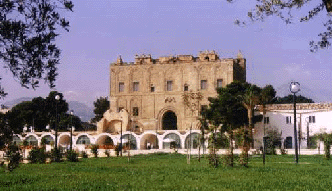...Best of Sicily presents... Best of Sicily Magazine. ... Dedicated to Sicilian art, culture, history, people, places and all things Sicilian. |
by Carlo Trabia | |||
Magazine Index Best of Sicily Arts & Culture Fashion Food & Wine History & Society About Us Travel Faqs Contact Map of Sicily
|
Recently, however, a quasi-Arabic garden has been designed in front of the palace, on the northern side facing central Palermo and the coast. Structured around white stone, the fountains and cascades are very ordinary-looking and less than impressive, while the garden itself is essentially a modern element rather than an attempt at re-creating a medieval one. If they fail to aesthetically complement the Zisa itself, they at least provide welcome relief from the abandoned land and low, ugly buildings which occupied this space for decades. It seems appropriate that the Zisa should have its own small park - in some form. A royal palace usually has its own "estate," however tiny. A contemporary palace of similar design, the Cuba, stands between a street and military barracks about a mile away off Corso Calatafimi. Though the Cuba was immortalised by Boccacio in his Decameron, the Zisa, largely restored but preserved in something resembling its original form, is in better condition. The Zisa garden is part of a general effort by Palermo's local government to make the city more appealing to residents and visitors alike. It's a good idea whose implementation is long overdue, and it is shared by the entire political spectrum. The garden is open to the general public, though there's a small charge for visiting the palace. Completed in the 1990s, the Zisa palace restoration itself leaves much to be desired. Matching stone was not used to reconstruct the missing parts of interior walls, and certain post-medieval details were left in place for no apparent reason. Restoring the large front windows to their medieval form would have been an architectural challenge, but one wonders why the small sculpted coat of arms --a seventeenth-century addition-- was left on the facade, and why the crumbling Baroque gateway arch was left standing in the space leading into the palace courtyard (a kind of fore-court once graced by a pool and fountains). The central segment of the row of low-lying eighteenth-century buildings separating the palace courtyard from the garden could have been removed, at least in the section around the unsightly Baroque gate, thus eliminating obstacles which obscure the otherwise clear view across the gardens. The Zisa garden is just one project being undertaken to make Palermo a more attractive city. Palermo's most ambitious public park is planned for the area next to the main university campus. Recently, Villa al Mare (the Foro Italico Garden) was opened following several years of development work. Similar to Dublin's coastal gardens, this is a coastal park spanning the area from the Saint Erasmus port to the Porta Felice gate and the Cala (the small bay at the end of Corso Vittorio Emanuele). It has expansive lawns, bicycle and jogging paths, efficient lighting, a sprinkler system and other practical features lacking a few blocks away in Piazza Magione, though it shares a common link. Villa al Mare was built as part of an extended coastline constructed with the rubble deposited there following the Allied bombing of Piazza Magione and other areas in 1943. Previously, the shore was located along the southern (inland) edge of what is now Foro Umberto Primo (formerly the Foro Italico), the seaside avenue bordering the Kalsa quarter near the city's fifteenth-century "Spanish" wall. An effort is being made to provide residents with the green areas overlooked during the Mafia-sponsored construction boom of the 60s and 70s. Part of the plan is to reduce traffic. In the next few years, construction is planned of an efficient underground (metro) line under Via Roma (beginning at the main railway station) and Via Libertà, making it easier to get around the city's historical and cultural districts, currently crippled by excessive traffic. A very modern way to explore an ancient city. About the Author: Architect Carlo Trabia has written for this publication and others. | ||
Top of Page |
 Built in the twelfth century in the distinctly
Sicilian Norman-Arab style, the splendid Zisa palace once stood in the middle of the large royal park in Palermo called
the
Built in the twelfth century in the distinctly
Sicilian Norman-Arab style, the splendid Zisa palace once stood in the middle of the large royal park in Palermo called
the